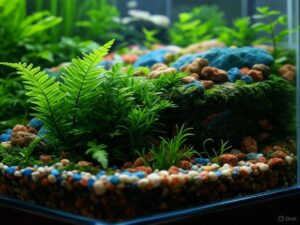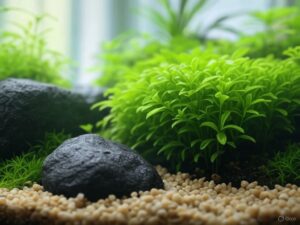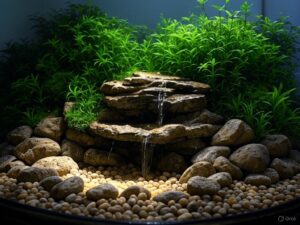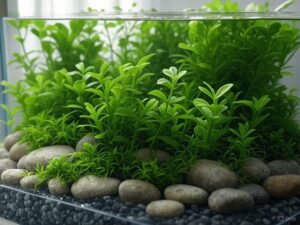Mastering Aquascaping: Practical Strategies to Avoid Common Mistakes
Aquascaping for Beginners: Picture a serene underwater paradise where vibrant plants, artistic rocks, and shimmering water harmoniously coexist, creating an enchanting scene. Aquascaping is an intricate art that transforms an ordinary aquarium into a stunning underwater masterpiece, merging creativity with scientific principles to deliver an engaging visual feast. This fulfilling hobby not only beautifies your living or working spaces but also promotes a peaceful atmosphere that can calm the mind and rejuvenate the spirit. Equipped with the right tools and knowledge, anyone can design an eye-catching aquascape that serves as a captivating centerpiece, inviting admiration and tranquility.
The journey to crafting your ideal aquascape begins with choosing the right tank size, a fundamental decision that sets the stage for your entire project. Opting for a tank that is too small may limit your ability to execute your creative vision effectively, while selecting an excessively large tank can result in daunting upkeep responsibilities. Carefully assess the available space in your home or office, considering how the tank will fit into the overall decor and ambiance, ensuring it enhances the existing aesthetic and fosters a sense of harmony throughout the environment.
Developing a clear and inspiring vision for your desired aquascape setup is critical for success. Do you envision a striking focal point that captures attention or a serene, low-maintenance habitat that brings tranquility? This vision will guide your choices in selecting the right plants, rocks, and fish that align with your artistic goals. Consider not only the visual aspects but also the functional relationships between each component, ensuring they work in synergy to create a cohesive and beautiful underwater landscape.
For those embarking on their aquascaping journey, a wise approach is to start with simpler designs. Although intricate layouts may appear more appealing at first glance, they can present significant challenges for beginners. Take the time to learn the fundamentals, such as understanding how different plants and rocks interact with each other, before progressing to more elaborate designs. By mastering these foundational skills, you will build the confidence necessary to expand your creative horizons and tackle more complex aquascaping projects.
Grasping the essential principles of aquascaping is vital to sidestepping common mistakes that can lead to frustration. With thoughtful planning and a dash of creativity, any ordinary tank can be transformed into a captivating work of art that enchants viewers and brings joy to your living space, making it a delightful environment for both you and your aquatic inhabitants.

Navigating Substrate Choices and Layout to Enhance Your Aquascape
The term “substrate” refers to the foundational material that establishes the base layer of your aquarium setup. While it may seem technical, it’s a crucial element in your aquascaping design.
Think of the substrate as the bedrock upon which your entire aquatic paradise thrives. It plays an instrumental role in the health of your plants, their growth, and the overall visual appeal of your aquarium. The right substrate choice can significantly influence the vitality of your plants and the overall balance of your aquatic ecosystem, making it a pivotal consideration in your design process.
Using an inappropriate substrate can disturb the equilibrium of your entire aquascaping design. Have you ever seen an aquarium that feels cluttered or lacks cohesion? Frequently, such issues arise from poor substrate choices. Select nutrient-rich substrates that provide essential support for plant growth, akin to offering them a diet rich in superfoods, enabling them to flourish and contribute positively to the ecosystem.
When choosing your substrate, resist the urge to prioritize aesthetics over biological functionality. While a visually appealing substrate may catch your eye, failing to meet the specific needs of your plants can lead to a beautiful but ineffective tank. Consider layering various substrate types to create an attractive yet practical foundation that supports the health and growth of your aquatic plants.
When it comes to layout, a seemingly random arrangement may appear visually stimulating, but it often results in a chaotic and disorganized look within the tank.
Design your aquascape with purpose and intention. Establish a clear plan for the placement of each element, adhering to it to achieve a polished and cohesive appearance. A thoughtfully structured layout enhances not only the visual appeal but also contributes to the overall balance and harmony of your aquarium, creating a captivating landscape that draws in admirers.
Remember that perspective plays a crucial role in aquascaping. Avoid creating a tank that appears flat or two-dimensional. By incorporating varying heights and depths using rocks, driftwood, and plants, you can create a more dynamic and realistic environment that captivates viewers and inspires a sense of wonder.
Be mindful that the arrangement of your aquascape can greatly influence its success or failure.

Optimizing Plant Selection and Care to Cultivate a Flourishing Aquatic Ecosystem
Selecting the right plants for your aquascape is not just about aesthetics; it’s like curating a mini-garden where each species must complement the others for a thriving ecosystem. The goal is to create an environment where your plants grow harmoniously together, avoiding competition for resources such as space and light, which can lead to a chaotic and unhealthy habitat.
When embarking on your aquascaping journey, the vast array of plant choices can be overwhelming. It’s easy to get carried away and overcrowd your tank, leading to a cramped and jungle-like atmosphere. Remember, allowing ample space for each plant to grow will not only help them thrive individually but will also promote a healthier and more balanced aquatic ecosystem. Space truly is your ally in fostering a vibrant and flourishing habitat.
Lighting is another critical factor that significantly impacts your plants’ health. Just as in a terrestrial garden, different aquatic plants have varying light requirements. Too much light can cause some plants to bleach out, while insufficient light can hinder their growth. Conduct thorough research on the specific lighting needs of each plant species before establishing your lighting system. This investment in understanding now can save you from potential headaches and complications in the future.
While the term maintenance may elicit groans, it is an essential aspect of keeping your plants vibrant and healthy. Regular pruning not only aids in managing growth but also maintains a neat and appealing tank appearance. Even a minor trim can significantly enhance the overall aesthetics of your aquascape, ensuring it remains a stunning focal point in your space.
Stay vigilant for signs of plant distress, such as yellowing leaves or stunted growth, which can indicate underlying issues with nutrients or light levels. Furthermore, pests can pose a serious threat to your plants. If you notice any unwelcome visitors feasting on your greenery, it is crucial to address the issue promptly to prevent larger infestations that could jeopardize the health of your aquatic plants.

Fostering Compatibility Between Fish and Plants for a Thriving Aquascape
Establishing a well-balanced ecosystem within your aquascape is akin to orchestrating a harmonious dinner party where all guests coexist peacefully. Your choice of fish is paramount, not only for the visual allure of the tank but also for ensuring a thriving environment that nurtures both fish and plant life.
Some fish species are known to thrive alongside specific types of plants, while others may pose a threat by consuming or damaging them.
Understanding which fish species can coexist harmoniously with your aquatic plants is essential to prevent chaos in your aquarium. Take the time to research compatible fish companions for aquascapes, such as tetras and barbs, which can introduce dynamic movement and vibrant color to your tank without harming the plant life.
Consider enhancing your aquascape by creating a comfortable and secure environment for your fish. Incorporating rocks and driftwood can provide essential hiding spots that help reduce stress for both fish and plants. These small shelters can serve as refuge areas, promoting a calm and natural atmosphere within your aquatic habitat, ultimately benefiting the overall ecosystem.
To maintain balance, ensure you allocate sufficient space for free-swimming fish while preventing plants from overcrowding the tank. This thoughtful arrangement leads to a healthier and more content aquarium ecosystem, benefiting both fish and aquatic plants.
When designing your aquatic landscape, remember that aesthetics and functionality must go hand in hand. An effective aquascape should consider both beauty and practicality. By balancing visual appeal with the functional needs of your ecosystem, you can create a flourishing aquatic environment that thrives.
Regular monitoring for invasive species is essential for maintaining a harmonious ecosystem.
While some newcomers may seem innocuous initially, they can rapidly disrupt the balance of your aquascape if left uncontrolled. To ensure a flourishing environment, it’s crucial to ensure that any new additions align with the design and specific requirements of your existing setup, preventing potential conflicts and maintaining a serene ecosystem.

Essential Equipment for Successful Aquascaping: Tools for a Thriving Environment
Cultivating a successful aquarium extends beyond just plants and fish; your equipment serves as the unsung hero of your aquascaping journey. Understanding the significance of proper gear is crucial, as lacking the right tools can turn your dream aquascape into a nightmarish scenario.
Start with a dependable filtration system, which acts like an air conditioner on a sweltering summer day, maintaining a clean and balanced habitat. A high-quality filter ensures the water remains crystal clear and free from harmful substances, providing a stable environment for both your plants and fish.
Next, consider your lighting requirements. Think of lighting as the sunlight for your tank; choosing the wrong type or intensity can inhibit your plants’ ability to photosynthesize effectively. Opt for LED lights that mimic natural sunlight, as they are energy-efficient and promote healthy growth for your aquatic plants.
Water quality is another vital aspect of your aquarium’s health. Regularly testing pH, nitrate, and ammonia levels is as essential as watering a terrestrial garden. Conducting routine tests can help you avoid major issues down the line, ensuring your aquarium remains a suitable habitat for its inhabitants.
Oxygen and CO2 levels are crucial yet often overlooked factors in maintaining a healthy aquarium. If you notice your fish gasping at the surface or observe your plants turning brown, it may indicate an imbalance in these vital gases. Consider using CO2 injectors to enhance plant growth, particularly in densely planted aquascapes requiring additional carbon dioxide for optimal development.
Finally, maintaining a consistent water temperature is imperative for the well-being of your aquatic life. Depending on the species in your tank, stabilizing water temperature is essential. Investing in heaters or chillers can help create the ideal environment for your aquatic inhabitants, ensuring they thrive and flourish in their underwater home.
The Article: Aquascaping for Beginners Appeared First On Unity Pets.
The Article Aquascaping Basics: A Beginner’s Guide Was Found On https://limitsofstrategy.com

